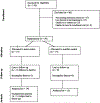Evaluation of a web-based fall prevention program among people with multiple sclerosis
- PMID: 31004969
- PMCID: PMC6948349
- DOI: 10.1016/j.msard.2019.04.015
Evaluation of a web-based fall prevention program among people with multiple sclerosis
Abstract
Background: Falls are common and impactful in people with multiple sclerosis (MS) but currently there is no accepted standard of care for fall prevention in MS. Evidence supports that the in-person, group-based, Free from Falls (FFF) program is associated with both immediate and six-month sustained improvements in mobility and balance and a reduction in falls, but program attendance is limited by access to the class at a given time and location and by the cost and availability of trained facilitators. Therefore, we developed and evaluated an online, web-based version of FFF, Free from Falls Online (FFFO).
Methods: Thirty people with MS who reported falling at least twice in the previous two months were randomized to FFFO or to a control group. FFFO consists of eight weekly sessions, each with an instructional and exercise component. Subjects in the control group were given a brochure on minimizing fall risk, a letter was sent to their treating physician informing them that the subject reported falling, and these subjects were invited to use the FFFO program at study completion. Outcomes included baseline demographics, falls prospectively reported for the eight weeks of intervention and the following three months, and a program satisfaction survey for the active group. Regression models were used to test for associations between treatment group and fall incidence.
Results: Subjects' mean age was 55.8 years, 70% were female, 73% had progressive MS, median Expanded Disability Status Scale (EDSS) score was 6.0, and subjects reported a median of two falls in the month prior to study enrollment. Although, in general, regression models demonstrated trends that those in the intervention group were less likely to fall than those in the control group, statistical significance was only achieved (p = 0.0038) with a post hoc model evaluating the relationship between the square of days and the probability of not falling. This model supported that those in the intervention group were slightly less likely to fall than those in the control group. This difference was most prominent in the first month of the study, less prominent in the following month, and not sustained three months following the intervention. User experience with FFFO was overall positive, with over 75% reporting the web-based program easy to learn and to use, 85% reporting the program was easy to follow, 62% reporting the material to be useful, and 77% finding the exercises to be a useful component of the program.
Conclusion: This study supports the viability of online delivery of self-management strategies in MS, suggests that FFFO may help prevent falls in people with MS, and provides the preliminary data needed to verify the findings of this pilot study of FFFO with a fully powered randomized controlled trial in people with MS.
Keywords: Accidental falls; Fall-prevention; Internet; Multiple sclerosis; Self-management.
Copyright © 2019. Published by Elsevier B.V.
Conflict of interest statement
Conflict of interest
All authors report no conflicts of interest relevant to this research study.
Figures


Similar articles
-
Erratum.Mult Scler. 2016 Oct;22(12):NP9-NP11. doi: 10.1177/1352458515585718. Epub 2015 Jun 3. Mult Scler. 2016. PMID: 26041800
-
People with multiple sclerosis use many fall prevention strategies but still fall frequently.Arch Phys Med Rehabil. 2013 Aug;94(8):1562-6. doi: 10.1016/j.apmr.2013.01.021. Epub 2013 Feb 4. Arch Phys Med Rehabil. 2013. PMID: 23391522
-
Free From Falls education and exercise program for reducing falls in people with multiple sclerosis: A randomized controlled trial.Mult Scler. 2022 May;28(6):980-988. doi: 10.1177/13524585211046898. Epub 2021 Oct 1. Mult Scler. 2022. PMID: 34595963 Clinical Trial.
-
Reducing falls and improving mobility in multiple sclerosis.Expert Rev Neurother. 2015 Jun;15(6):655-66. doi: 10.1586/14737175.2015.1046377. Epub 2015 May 14. Expert Rev Neurother. 2015. PMID: 25973774 Review.
-
Effectiveness of robotics fall prevention program among elderly in senior housings, Bangkok, Thailand: a quasi-experimental study.Clin Interv Aging. 2019 Feb 18;14:335-346. doi: 10.2147/CIA.S182336. eCollection 2019. Clin Interv Aging. 2019. PMID: 30863027 Free PMC article. Review.
Cited by
-
Interventions for preventing falls in people with multiple sclerosis.Cochrane Database Syst Rev. 2019 Nov 28;11(11):CD012475. doi: 10.1002/14651858.CD012475.pub2. Cochrane Database Syst Rev. 2019. PMID: 31778221 Free PMC article.
-
Effectiveness of Fewer Falls, an online group-based self-management fall prevention programme for people with multiple sclerosis: protocol of a randomised controlled trial.BMJ Open. 2025 Jan 6;15(1):e089217. doi: 10.1136/bmjopen-2024-089217. BMJ Open. 2025. PMID: 39762097 Free PMC article.
-
Development of Fewer Falls in MS-An Online, Theory-Based, Fall Prevention Self-Management Programme for People With Multiple Sclerosis.Health Expect. 2024 Aug;27(4):e14154. doi: 10.1111/hex.14154. Health Expect. 2024. PMID: 39032151 Free PMC article.
-
Attrition Within Digital Health Interventions for People With Multiple Sclerosis: Systematic Review and Meta-analysis.J Med Internet Res. 2022 Feb 9;24(2):e27735. doi: 10.2196/27735. J Med Internet Res. 2022. PMID: 35138262 Free PMC article.
-
Linking Pathogenesis to Fall Risk in Multiple Sclerosis.Arch Intern Med Res. 2025;8(1):36-47. doi: 10.26502/aimr.0194. Epub 2025 Jan 30. Arch Intern Med Res. 2025. PMID: 40041760 Free PMC article.
References
-
- Chiaravalloti ND, DeLuca J, 2008. Cognitive impairment in multiple sclerosis. LancetNeurol. 7 (12), 1139–1151. - PubMed
-
- Finlayson M, Peterson EW, Cho C, 2009. Pilot study of a fall risk management program for middle aged and older adults with MS. NeuroRehabilitation. 25 (2), 107–115. - PubMed
-
- Friemel TN, 2016. The digital divide has grown old: determinants of a digital divide among seniors. New Media Soc. 18 (2), 313–331.
Publication types
MeSH terms
Grants and funding
LinkOut - more resources
Full Text Sources
Medical

